
- Part One: Aerial Attack
- Part Two: What’s In A Name?
- Part Three: Haunted Howls
- Part Four: Le Sensible Trousers
- Part Five: Farewell, French Friend
Part One: Aerial Attack
It’s said to be good luck should a bird happen to do its business just as it’s flying over your head. If that is indeed the case, then MOTOR’s new Peugeot 208 GTi long-termer and I should be in for a very successful relationship. Thankfully, it was the car, not me, that copped the aerial attack.
Having picked up the car from Peugeot dealer Regan Motors, it was parked under a tree near the office, which was apparently home to a flock of Renault fans, as by the time we left for the day, the 208 was in a right state. I swear, birds must have been diverting from their migratory flights for the opportunity to take a dump on the poor Pug, it was that bad.
An unpleasant start for CTG 49F, but a quick trip through a carwash and the introductory period could begin.
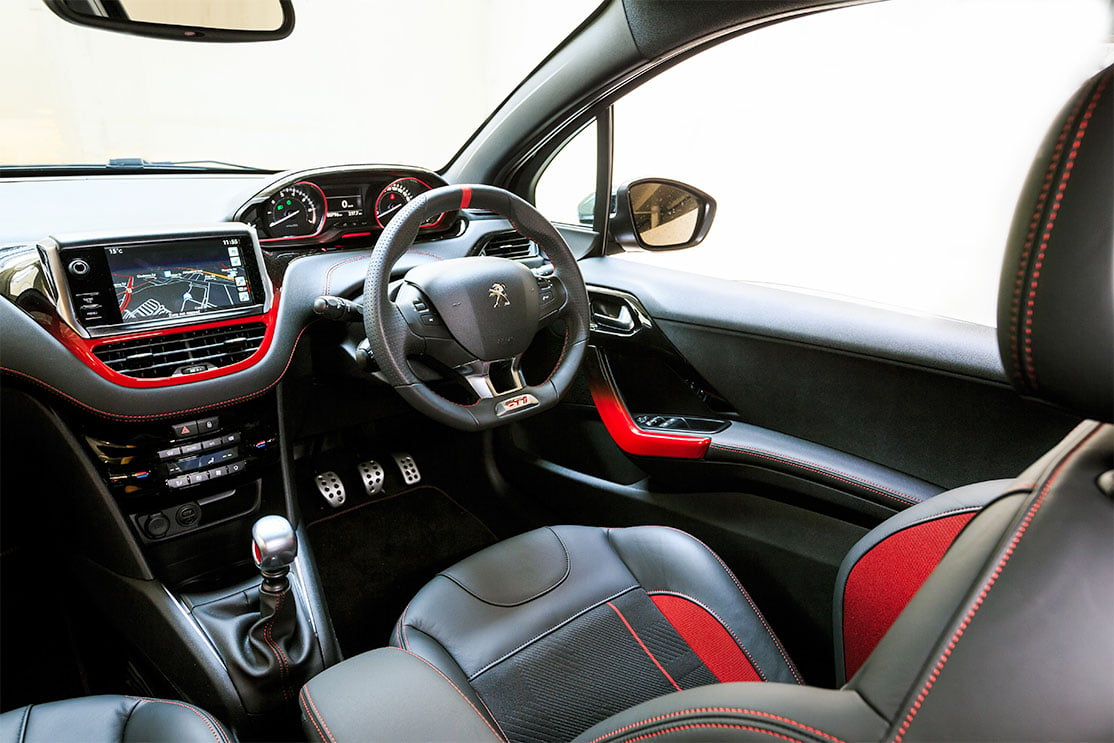
So why’s it here? Well, the 208 had the unfortunate luck of arriving on the market at about the same time as the Fiesta ST, which has proved itself to be one of the most fun cars of modern times. Ford’s baby gave the 208 GTi a bloody nose in a comparison in our December 2013 issue, and repeated the drubbing at last year’s PCOTY, finishing third to the Pug’s ninth.
But burrowing away in the back of our minds was the suspicion the 208’s talents might not reveal themselves fully in the quick-burn comparison environment – here’s its chance to prove itself. First impressions are that our suspicions were correct. Having just returned a long-term Fiesta ST – Morley still won’t talk to us – we’re perfectly poised to compare the two on a day-to-day basis.
As fun as the Ford is, its frenetic nature can occasionally be wearing; the Peugeot’s calmer demeanour is paying dividends at this early stage. The softer suspension setup that costs it during max-attack motoring is proving its worth on the daily commute, rounding off the worst of irregularities Melbourne’s roads can serve up.
At $30,470 as-tested ($480 for metallic paint), the Peugeot asks for a hefty premium over the Fiesta, but the interior ambience justifies the extra spend. The seats are comfy, the seven-inch multimedia touch screen keeps the button count to a minimum and there are nice touches everywhere like the contrasting red stitching on the seats, steering wheel, gearshift boot and dash; red illuminated rings surrounding the dials, and the way the plastic fades from a rich red to a deep black on the door handles and screen surround.
But it’s not all so hunky-dory. The glove box may be chilled but it’s also so small it’s pretty much useless, the alloy gear knob is so cold in a Melbourne winter it burns to touch, and then there’s the driving position… but expect more on that in a future update.
Arriving with just 577km on the clock, the 208’s early use has been pretty gentle. The handbook doesn’t specify the need for any running-in procedure, but old-school mechanical sympathy is preventing the upper reaches of the tachometer being explored before the odo ticks over to at least four figures.
This is frustrating, as even with limited rpm the 208 is a rapid machine.
Part Two: What’s In A Name?
We’d yet to bond, Pug and I. I’m not traditionally a fan of naming cars, but with its blunt nose and forward-leaning stance, the Peugeot 208 GTi kind of resemblances those dogs that everyone bar me seems so fond of. It’s a lot catchier than CTG 49F, anyway.
Prior to this month’s Bang for your Bucks, Pug’s primary use had been boring commuter stuff. Its city-car origins make it quite adept at this, but this is a junior hot hatch, so I was looking forward to stretching its legs on track at BFYB. Here it acquitted itself well, holding its own against the Ford Fiesta ST and Renault Sport Clio in terms of pace, though its higher price and lower judges’ ranking cost it.
Well, slightly lower for most judges. While four of the five put Pug somewhere between fifth and seventh on their scorecards, one harsh critic put it 10th. Which was, erm, me. While enjoyable when chasing lap times, it lacked the Fiesta or Clio’s playfulness.

Obviously, judging it here solely on racetrack performance is ridiculous, so to make it up to Pug for being so mean I planned a (hopefully) redeeming road trip. Since moving to Melbourne in early 2011, I’ve been itching to try the Great Alpine Road over the Victorian Alps, connecting Wangaratta on the Hume Highway to the East Coast’s Bairnsdale.
Of course, to get to Wangaratta means 250-odd kilometres of speedo-watching on the Hume, lest you be pinged by one of the sneakily placed cameras or even more sneakily hidden Highway Patrol cars. Here the 208 proves comfortable and economical, if not quite as parsimonious as Peugeot’s 4.7L/100km highway claim.
A quick diversion to Glenrowan allows a visit to a section of the old Hume Highway, very close to where journo Mel Nichols famously managed to max a Phase III. Obviously, speed limits prohibit such behaviour today, but it’s interesting to note that at even its 227km/h max, the mighty V8 behemoth would see the little turbo hatch slowly edge away.
The first 100-or-so km of the GAR are relatively uneventful, but for a great road and sensational scenery, a diversion to Mount Buffalo is recommended. Following an overnight halt in Bright, chains are hired early next morning as, despite the crisp, clear skies and high-teens temperature, it’s a $2000 fine if you’re discovered travelling without chains during the declared snow season.
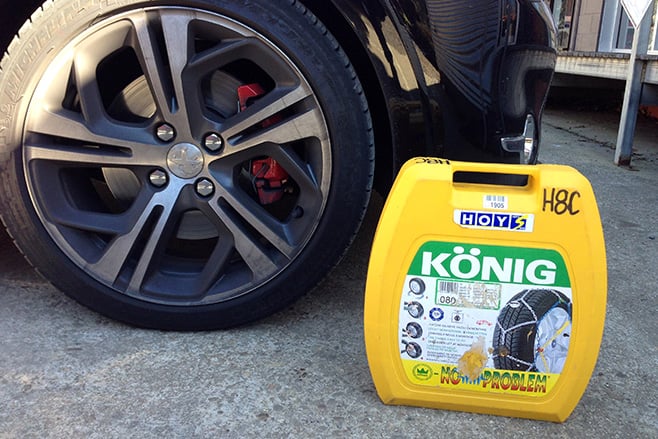
Beyond Harrietville, the road turns twistier and climbs steeply. These narrow Alpine passes should suit the Peugeot to a tee, but though it’s agile, and a class-leading 275Nm punches it out of tight corners well, it feels a bit soft at maximum attack. It’s still quick, but feels most rewarding at around seven- or eight-tenths.
Following the breathtaking views atop Mount Hotham, the road becomes wider with fast, flowing sweepers all the way to Omeo. It’s supercar country, but against expectations suits Pug well. Its slower steering and more stable balance inspire high-speed confidence and the soft brake pedal is less an issue rolling from one long corner to the next.
Past Omeo and the road changes again, winding its way through rocky canyons and thick bushland. The corners are medium-speed, third- or fourth-gear, with plenty of bumps to contend with, and it’s here the Pug’s supple chassis finds its sweet spot, soaking up undulations and settling into slight four-wheel drifts.
Over lunch in Lakes Entrance, I reflect that the last 100km proves the 208 GTi isn’t without its charms, but it does require a certain type of road to give its best. To draw a slightly strange comparison, the Peugeot is like the Grand Tourer of the mini hot hatch brigade.
I would’ve had more fun in a Fiesta ST or Renault Clio RS, but would I have felt as fresh in either after 970km over two hard days as I did in the Peugeot? I’m still not sure we’ve bonded, but there’s respect for its abilities that not had previously existed. And the road? It was epic.
Part Three: Haunted Howls
Let’s talk engines. Specifically, the 1.6-litre turbo-four under the bonnet of our long-term Peugeot 208 GTi. It’s the go-to configuration in the baby hot-hatch segment, now that 2.0-litre atmo engines are a relic of a bygone age and 2.0-litre turbos are deemed overkill.
With 147kW, Pug matches its rivals from Renault and Ford (the latter producing the figure on overboost), but the 208 is the torque king with 275Nm, at least until the new Volkswagen Polo GTI arrives next year with a thumping 320Nm from its ‘big block’ 1.8 and until the Fiesta’s overboost hits full stride in third gear.
Still, it’s 35Nm more than the Clio can muster, and it plays a crucial role in the Peugeot’s ability to punch out of corners.
This attribute came in handy at a recent hillclimb, held by the Kyneton Car Club at Bryant Park Hillclimb, better known as Haunted Hills. Australian hillclimbing is a bit of a unique proposition, as quite often courses go downhill as well as up. I once spoke to a visiting Russian journalist who found this immensely confusing, saying: “For me, a hillclimb always climb!”
Regardless of the technicalities, Haunted Hills is a fantastic circuit; tight and technical, it rewards bravery yet punishes mistakes with enormous undulation and a great mix of corners. While a bit underwhelming on circuit, following last month’s epic road trip I suspected the layout might suit Pug.
Before departing, however, a change of tyres was in order. A full day’s trackwork at Bang For Your Bucks plus two days being flung around Victoria’s alpine region had taken their toll on the Peugeot’s front sidewalls, but the rears were still reasonably fresh so a quick front-to-back was all that was required.
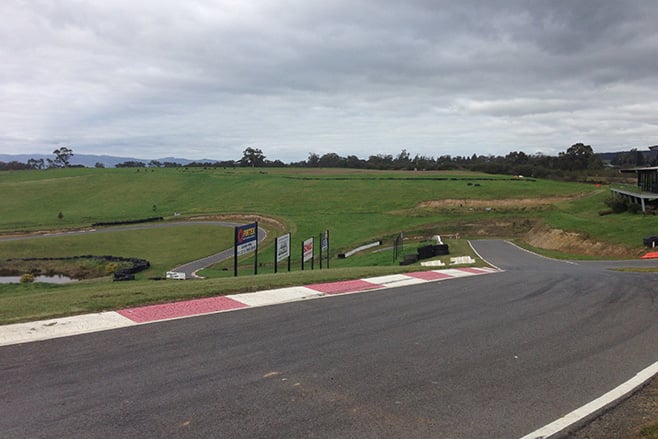
Imagine my surprise when lifting up the boot floor revealed a full-size spare! Well done, Peugeot. Too often spare tyres are deleted to free up boot space or reduce weight chasing fuel economy figures, but they really are a godsend. It’s like insurance, you’ll be thankful you have it when you need it.
Unlike a track day, where you can go around and around to your heart’s content, slowly shaving time off each lap, hillclimbing piles on the pressure. We competed on two different course layouts, with four runs on each. Being my first time at the track (and not my car!) I decided a cautious approach would be best, getting a ‘banker’ time in and trying to improve from there.
My competition comprised a wild variety of cars, everything from a tidy Ford XY Fairmont with huge power to stripped-out Subaru WRXs on semi-slicks to dog-eared ’80s sports coupes (Honda Accord, Toyota Celica) living a second (or 10th) life as track hacks.
Lessons learned during the first couple of runs are staying off the kerbs in braking and traction zones as they’re incredibly slippery, but use them as much as possible mid-corner to widen the track and be more committed in the faster corners but more gentle with the throttle in the slower ones.
All that torque easily lights up the inside wheel, wasting precious tenths during corner exit.
The time improves from a 63.13sec to a 62.55sec over four runs, but the last was scrappy and I’m left disappointed, especially as another 0.50sec would’ve lifted me from 11th to sixth! From the first run on the second course, I can tell Pug enjoys the more flowing layout better, as do I. A clean final run nets a 67.38sec, good enough for fourth place.
Combining the times for both courses leaves Pug sixth outright, wedged between two WRXs – not bad for a totally standard road car on tyres that had given their best.
For a more in-depth look at the Haunted Hills circuit, check out the Peugeot’s live feed on our website, we’re already planning our next visit.
Part Four: Le Sensible Trousers
Time to (reluctantly) put my sensible hat on. The last couple of months’ updates have focused strongly on what the Peugeot is like to drive, but this month we’re investigating the more mundane but arguably more important topic of interior accommodation.
After all, unless you happen to moonlight as a Hollywood stunt double, all of your time travelling by car is going to be spent inside it. And the vast majority of that will take place in traffic jams, driving to the shops, picking the kids/partner up – y’know, boring everyday life stuff.
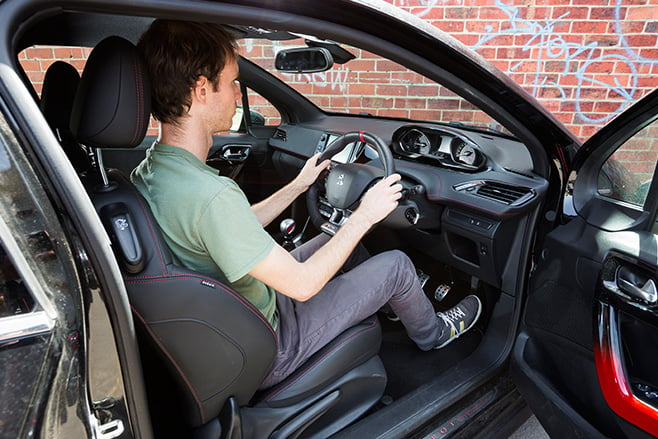
How does Pug stand up? Good. And bad. Let me explain. In general the Peugeot 208 GTi interior is a nice place to be. Premium touches like the way the plastic blends from black to red, the leather padding on the dash and the contrasting red stitching give it some flair and lift it above the likes of the Ford Fiesta ST and VW Polo GTI.
There’s definitely evidence of its cheap-car origins – the dashtop and top of the doors are made from hard, scratchy plastic – but Peugeot’s made an effort with the stuff you interact with every day.
The big touchscreen is welcome, though not particularly intuitive – things like switching to Bluetooth audio tend to happen by happy accident. Or maybe I just need to read the manual.
Possibly the most controversial aspect of the 208 GTi, though, is its driving position. The seat is quite high and to properly see the dials you need to have the wheel almost in your lap – it’s all very French. I can see why Peugeot did it. In its base form, Peugeot’s 208 is primarily a city car and the raised perch aids vision when dealing with traffic.
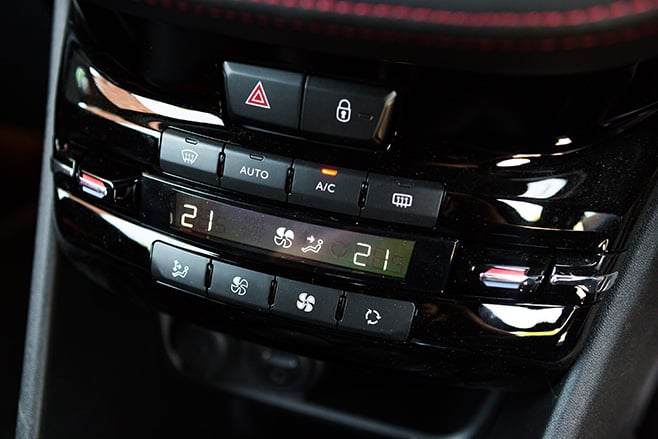
Trouble is, in a performance context you want to be as low as possible in the car, and it’s this lack of connection, rather than the unusual driving position itself, that for me is the bigger problem.
Pug goes home soon, which means in our instalment it’s time to say goodbye.
TEMPERATURE TANTRUMSFor some unknown reason, the 208 allows you to adjust the cabin temperature in half-degree increments until 24°C, above which it only permits whole-degree increments.
PERCHED ALOFTHigh driving position forces the wheel into your lap in order to clearly see the gauges. It’s not as bad as some make it out to be – you get used to it – but it feels slightly odd in a car with such sporty aspirations.
PEDALLING HARDPedal layout is a bit all over the shop, though in practice it isn’t as bad as it looks thanks to a fairly soft brake pedal. They are incredibly slippery with wet soles, though.
HANDS OFFAn alloy gearknob probably sounded like a great idea in a marketing meeting, but should it be a particularly cold or hot day it renders changing gear impossible without hand protection.
Click here to read our full review on the Peugeot 208 range
Part Five: Farewell, French Friend
After four months and just over 6000km, it’s goodbye to CTG 49F, better known as Pug. Is it a fond farewell, all misty eyes and waved handkerchiefs? Or more a case of see-ya-later, and don’t let the garage door hit you on the way out? Neither, really.
While there’s no doubt the Peugeot 208 GTi is a good car, not one member of staff managed to form a close bond with it, despite their best efforts. Certainly no one complained about driving it, but equally, no one was itching to snare the keys come weekend time. To put it another way, if Pug were a human, we’d hang out every now and then, but we’re certainly not besties.
Undoubtedly, Pug’s best attribute was its engine. Whether it was an urban 60km/h or a highway 110km/h, it was always surprising how quickly the speed limit arrived. A fulsome 275Nm, available from just 1700rpm, allied to the lightest kerb weight in its class, meant there were no complaints about the Peugeot’s straight-line prowess.
For those who care about such things, we clocked 0-100km/h in 6.96sec and a 15.14sec quarter-mile at 154.44km/h. Average fuel use of 8.2L/100km wasn’t too shabby, either, given we were fond of using the performance.
We liked the interior, too. Mostly. It feels like a nice place to be and there’s a decent amount of room in the rear. The folding rear seats came in handy on more than one occasion as well.
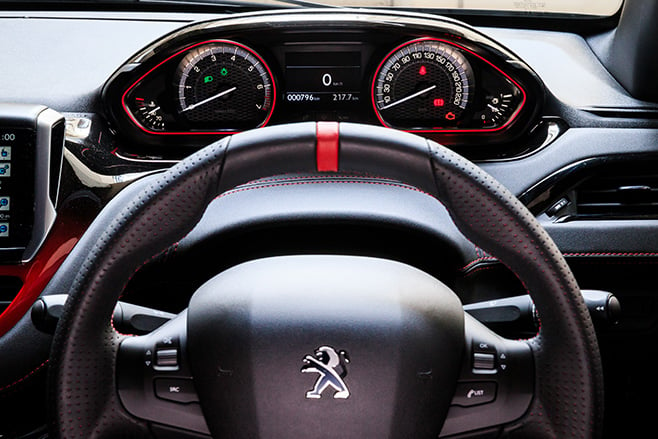
As you’d hope in four months, nothing fell off or stopped working, but a couple of things do work against it. Firstly, on hot or cold days, changing gear is near impossible without burning your hand on the alloy gearknob. Secondly, while the driving position works in a city car context, sitting so high with the steering wheel so low feels weird in what is a sporty hatch.
While we are on the subject of steering, with such a tiny tiller you would expect the steering to be razor-sharp, but it’s actually quite a slow rack – it’d be positively naval with a regular-sized wheel.
This lack of response manifested itself in other ways, too. The brakes were quite robust but the soft pedal never inspired confidence, though it did make it quite easy to heel-toe your way around town pretending to be a racing driver.
The handling was similarly soft-edged, though Pug did shine on a certain sort of road. Medium-speed corners, preferably with a few bumps thrown in, tackled at about eight-tenths were its forte.
Tighter roads – the type you would think a mini hot hatch would shine on – became an exercise in frustration, with the 208 lacking the front-end to turn in sharply and pivot the rear. It’s certainly quick, but just not capable of delivering the same involvement and fun factor as its key rivals.
Which is the whole point, really. For all its positives, if it were our $30K, we wouldn’t be driving away in a 208 GTi. If you get your buzz from driving neat and tidy, or if the 208 GTi is your first performance car, you’re probably going to love it.
Just make sure you never drive a Fiesta ST or Clio RS. And then there’s the updated Volkswagen Polo GTI coming later in 2015. In such a tough market, merely good isn’t good enough.
Hope is at hand, however, with the imminent of the faster, sharper, more focused 208 GTi 30th Anniversary. Can it take that crucial final step?




